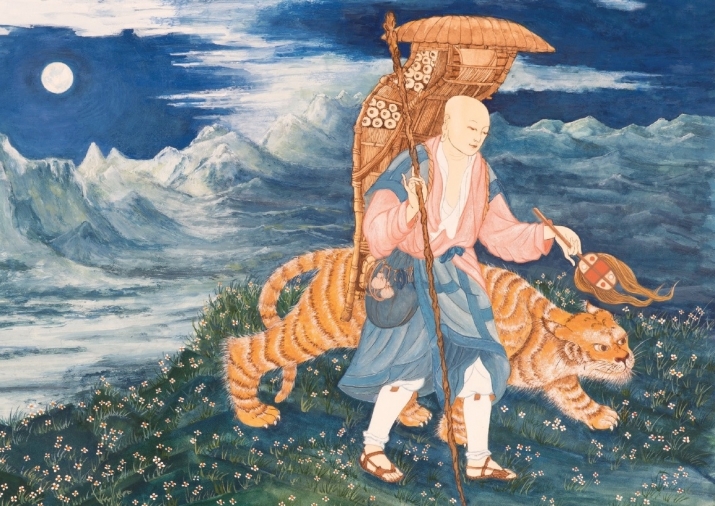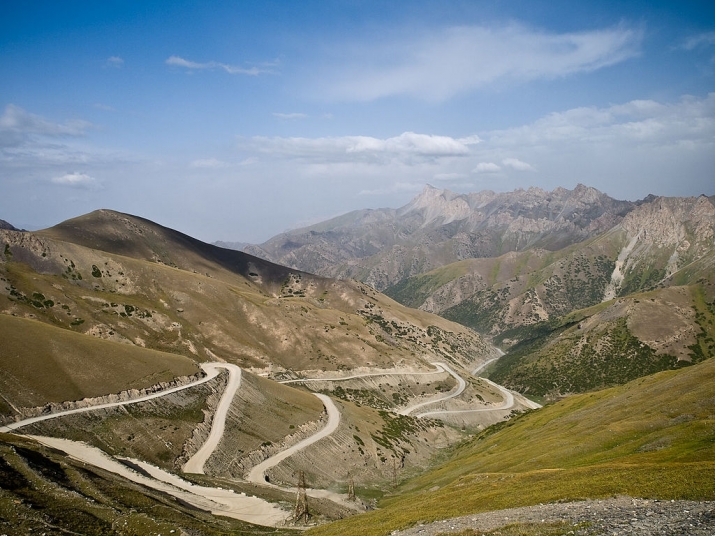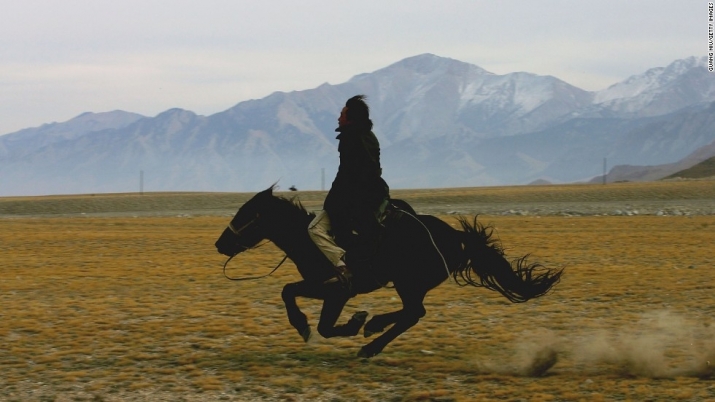FEATURES|THEMES|Commentary
Buddhistdoor View: Buddhist Hopes for China’s Silk Road Initiative
 Roberta Mansell, © "Further Stories from the Old Silk Road." Distributed by Kodansha Europe Ltd. From www.thebuddhistsociety.org/page/shop/further-stories-from-the-old-silk-road
Roberta Mansell, © "Further Stories from the Old Silk Road." Distributed by Kodansha Europe Ltd. From www.thebuddhistsociety.org/page/shop/further-stories-from-the-old-silk-roadOn 14–15 May, China will host a long-awaited summit on the Belt and Road Initiative, also known as One Belt, One Road. The initiative is the flagship diplomatic policy of president Xi Jinping, and the greatest hope of the Chinese government to establish and consolidate a leading role in world trade and international leadership. It is a truly ambitious project presently characterized by economic initiatives being implemented across Eurasia and Africa. Examples of these infrastructure, banking, and commercial projects have made international headlines, such as “First freight train linking UK with China arrives in Yiwu” (Deutsche Welle) or “Cambodian Domestic Helpers to Take the One Belt, One Road to Hong Kong"(The Diplomat).
The project spans both the land-based Silk Road Economic Belt (with nodes and corridors from the Russian Far East to Western Europe) and the Maritime Silk Road (sea routes winding from Southeast Asia along the African and Arabian coasts to the Mediterranean). The Chinese government hopes that the initiative can invoke historical examples of cooperation, mutual benefit, and diversity while projecting a contemporary sense of sustainable globalization and development.
The upcoming summit will be an important test for China as well as other countries that are participating. Even countries that initially expressed muted reactions to China’s Belt and Road Initiative have now shown interest. As reported by The South China Morning Post, “The Japanese government recently confirmed the secretary-general of Japan’s ruling party would attend a summit in Beijing in May regarding Chinese plans to revive the ancient Silk Road trade route. That confirmation is seen as a signal that Japanese leader Shinzo Abe is willing to improve bilateral relations amid heightened tensions over North Korea.”
 China's first freight train from Yiwu rolls into London. From gbp.org
China's first freight train from Yiwu rolls into London. From gbp.orgChinese Buddhists in Hong Kong as well as in mainland China have been overall supportive of the Belt and Road Initiative. Ven. Xuecheng, president of the Chinese Buddhist Association (the most important Buddhist body in the country), said that mutually beneficial economic relations and ethnic harmony once went hand in hand with religious co-existence and non-violent communication. Senior monastics and laypeople have expressed (mostly privately, but also at lectures and seminars) a shared pride and investment in the Belt and Road Initiative.
Since Buddhist institutions in China are very diverse and there is no central governing power, no official Buddhist stance on the initiative, or on how Buddhism should link up with the Belt and Road Initiative, has been taken. Yet some concrete examples of the interaction between Buddhism and international politics can be found in “Buddhist” diplomacy, where we see Buddhist values or figures (often from the distant past rather than the present) being integrated into implicit bilateral or multilateral ideals of unity, dialogue, and fellowship.
One example is the Tang-era Chinese pilgrim Xuanzang (c. 602–64), who is among the most famous historical figures to be invoked by Xi and Indian prime minister Narendra Modi as a bridge between China and India. This happened in 2015, when they visited Giant Wild Goose Pagoda in Xi’an, which is associated with Xuanzang. Even Sino-Japanese ties, which are traditionally rocky, might benefit from some Buddhist diplomacy represented by Ingen Ryuki, a Japanese monk who Xi praised at a talk given in Beijing in 2015 and is since receiving renewed attention. Perhaps in the future we might even see An Shigao of Parthia (fl. c. 148–80) or Lokakshema of Gandhara (b. 147 CE) from the Kushan era—the earliest Central Asian monks to translate the Buddhist scriptures into Chinese—as potential figures of unity for China and the Central Asian nations.
 Taldyk Pass, a year-round pass in the Alay Mountains of Kyrgyzstan's Osh region. From wikimedia.org
Taldyk Pass, a year-round pass in the Alay Mountains of Kyrgyzstan's Osh region. From wikimedia.orgIn a succinct description of the core values of Chinese Buddhism, the introductory volume Approaching Buddhism (2017) argues: “The byproducts of Pure Land faith—such universal and personal values as integrity, humility, repayment of kindness, pursuit of the Way amid modest circumstances, and a sense of optimism—had a far-reaching influence on the spiritual life of the Chinese people. And they greatly enhanced social well-being and stability.” This is the unique inheritance bequeathed by Chinese Buddhism to the human story: an expression of Mahayana Buddhism characterized by, as we mentioned in a previous commentary, a pragmatic approach to spiritual practice, an embrace of universal salvation, and a sense of modern Buddhism as being about life and relating to others.
Many of these core values relate to the Belt and Road initiative and reflect the needs of countries across Eurasia. For example, two things have characterized Asia for much of human history: diversity and poverty. China is, by its own standards, a developing country, and president Xi presented the current regime’s aim of creating a “moderately prosperous society” during the National Party Congress meeting of 2015. “Pursuit of the Way amid modest circumstances” (see above) is a relevant component of the revival of Eurasia’s interdependent economies and cultures. In the rhetoric of the Belt and Road Initiative we see terms such as “mutually beneficial trade and diplomacy,” which ideally do not rely on imperialism or the vassalage of client states.* Mutual benefits based on equality could be reframed as comradeship and camaraderie, something that can be found in both Chinese Buddhism and traditional Asian societies.
 Horseman along the Tian Shan corridor that passes through China, Kazakhstan, and Kyrgyzstan. From unesco.org
Horseman along the Tian Shan corridor that passes through China, Kazakhstan, and Kyrgyzstan. From unesco.orgHopefully, the Belt and Road Initiative can absorb the principles of Chinese Buddhism because there are real, shared affinities. If this happens, many Buddhist institutions and individuals will work hard to support the initiative as they will see the values of the teachings they have pledged themselves to reflected in a project of an immense diplomatic and economic significance.
The same hope for shared values with Buddhism also applies to the purpose of national rejuvenation touted as the Chinese Dream. The Chinese Dream is related to the Belt and Road Initiative, but since the former is more of a domestic undertaking involving different dynamics, challenges, and contexts, we will have to leave this discussion for another day.
* President Xi has emphasized the “Three No’s”: No interference in the internal affairs of other nations, no seeking to increase so-called “spheres of influence,” and no striving for hegemony or dominance.
See more
28 heads of state confirm attendance at China’s belt and road summit next month (The South China Morning Post)
First freight train linking UK with China arrives in Yiwu (Deutsche Welle)
Cambodian Domestic Helpers to Take the One Belt, One Road to Hong Kong (The Diplomat)
How a 17-century monk is boosting China-Japan ties (The South China Morning Post)
A brilliant plan: One Belt, One Road (CLSA)
Related features from Buddhistdoor Global
Buddhistdoor View—One Belt, One Road: Ideas for Buddhist Dialogue Across Asia
Buddhistdoor View: Mahayana Buddhism’s Unique Place in History and Chinese Civilization
Book Review: Approaching Buddhism—An Introduction to the Buddhist Tradition from the Pure Land Perspective
The Xuanzang Memorial: Evoking China and India’s Buddhist Past and Future














